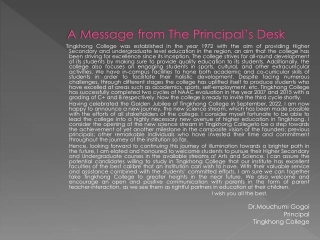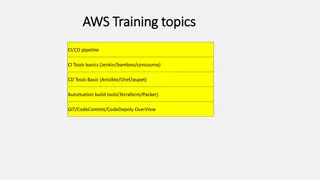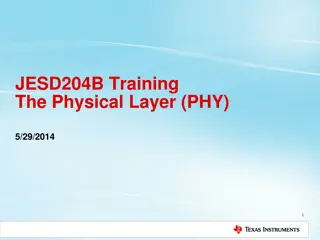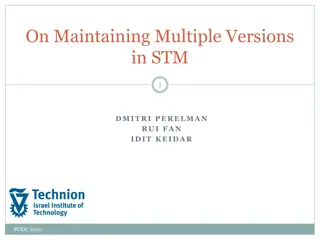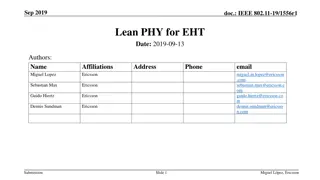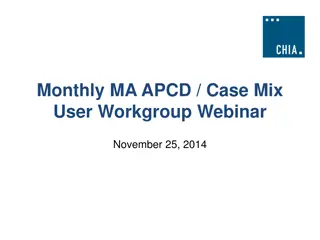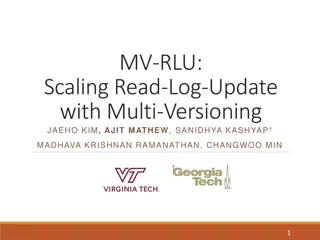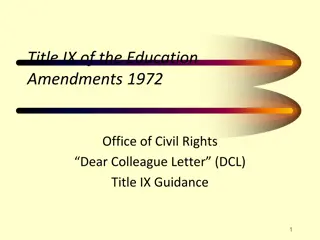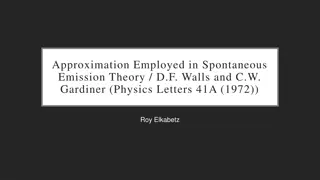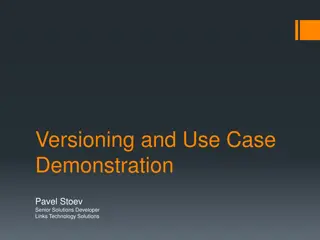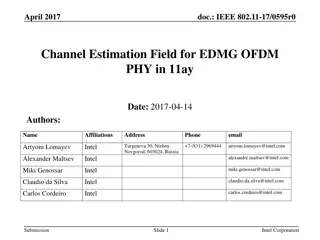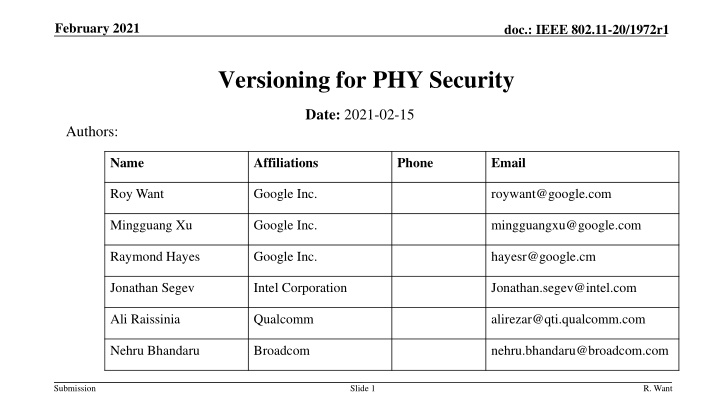
IEEE 802.11-20/1972r1 Versioning for PHY Security
Exploring the need for versioning in PHY security protocols to address potential future attacks, this document delves into the background, problem statement, and solutions for ensuring a secure protocol. By implementing a Secure LTF versioning mechanism, the protocol can be smoothly upgraded when necessary, offering users enhanced security options and decision-making capabilities.
Download Presentation

Please find below an Image/Link to download the presentation.
The content on the website is provided AS IS for your information and personal use only. It may not be sold, licensed, or shared on other websites without obtaining consent from the author. If you encounter any issues during the download, it is possible that the publisher has removed the file from their server.
You are allowed to download the files provided on this website for personal or commercial use, subject to the condition that they are used lawfully. All files are the property of their respective owners.
The content on the website is provided AS IS for your information and personal use only. It may not be sold, licensed, or shared on other websites without obtaining consent from the author.
E N D
Presentation Transcript
February 2021 doc.: IEEE 802.11-20/1972r1 Versioning for PHY Security Date: 2021-02-15 Authors: Name Affiliations Phone Email Roy Want Google Inc. roywant@google.com Mingguang Xu Google Inc. mingguangxu@google.com Raymond Hayes Google Inc. hayesr@google.cm Jonathan Segev Intel Corporation Jonathan.segev@intel.com Ali Raissinia Qualcomm alirezar@qti.qualcomm.com Nehru Bhandaru Broadcom nehru.bhandaru@broadcom.com Submission Slide 1 R. Want
February 2021 doc.: IEEE 802.11-20/1972r1 Abstract The Secure LTF protocol is a potential target for a future as yet unknown attack, and may need to be upgraded if one comes to light. Outline Background Problem Statement Versioning of PHY Security Summary Strawpoll By planning for this possibility, and using a Secure LTF versioning mechanism, we can smoothly upgrade the protocol, make the right decisions in the field, and provide users with feedback about their security options; whether to proceed with caution, or not. Changes relative to : TGaz_Draft D3.0 Submission Slide 2 R. Want
February 2021 doc.: IEEE 802.11-20/1972r1 Background We have been discussing 11az PHY Security options from 2016-2020, and there is still no unanimous consensus on the best approach for a Secure LTF protocol, (although we have agreed on a compromise). - Randomized 8PSK[6], 64QAM[2], 64QAM + 4PSK [5], 1024QAM[1,3], DFT Pre-coded OFDM [4] Attacker methods include using a Viterbi decoder, Sphere decoder in the frequency domain, MMSE sample-by-sample in the time domain. Attacks don t need to be perfect, and can take advantage of probabilistic weaknesses in the coding and modulation, and then after several attempts may succeed. Submission Slide 3 R. Want
February 2021 doc.: IEEE 802.11-20/1972r1 Problem Statement After the 11az standard is productized, it s possible we may find other attacks that need to be addressed with a new, or improved, variant of the Secure PHY protocol (it would become a priority). As a result, there may be new and old variants of the protocol in the field. For PHY Security versions, especially for key/lock applications, for a suitable user experiences we would need a coexistence mechanism: 1. Negotiation for the highest level of LTF security protocol solution. 2. Enable a user setting to define/override the LTF security policy level. Submission Slide 4 R. Want
February 2021 doc.: IEEE 802.11-20/1972r1 Previous Comments Addressed Versioning might be better addressed at the application level What kind of user experience would be enabled? Consider adding a new version subelement rather than overload an existing field We could address versioning if/when a vulnerability is found in the future. Are version numbers ordered by improving security robustness? Submission Slide 5 R. Want
February 2021 doc.: IEEE 802.11-20/1972r1 EXAMPLE using the Secure LTF version during FTM Request negotiation ISTA: Key App Security Menu RSTA: Car Lock Security Menu (available through dash console) ISTA RSTA User Selects: 1. Car security level must match the key s level, or block (terminate) User Selects: 1. Key security level must match the car s level, or block (terminate) 2. Permit Key with a lower (older) security level to open car. (less safe warn user, display version used) = < 2. n/a 3. Allow phone to use a lower security level set by car (less safe warn user, display version used) > 3. n/a Submission Slide 6 R. Want
February 2021 doc.: IEEE 802.11-20/1972r1 Secure LTF protocol version subelement Insertions: addition of description of Secure LTF protocol versioning subelement at the end of section 9.4.2.298 (Ranging Parameters element) and update Table 9-322h23fd (Ranging Subelement IDs for Ranging Parameters), with a new entry for subelement 2, formally reserved; and 11.21.6.3.4 (Negotiation for Secure LTF in the TB and Non-TB Ranging measurement exchange) B0 B7 B8 B15 B16 Secure LTF Protocol Version Subelement ID (2) Length Bits: 8 8 8 Figure 9-788edm1 Secure LTF protocol version subelement The Secure LTF protocol version subelement may be included in the Ranging Element of the FTMR and the initial FTM frame, to indicate the Secure LTF protocol version number proposed. This represents a negotiation for the version proposed from ISTA to RSTA, and the response from RSTA to ISTA. If it is not included, this is equivalent to proposing version 0. The version number will be incremented by the IEEE for each new Secure LTF protocol supported by the standard, and will be reflected by the inclusion of this subelement with that version number during negotiation. If the versions differ, each STA can then decide if it wishes to proceed with, or terminate, the ranging request. This decision can be made based on a security policy established a priori by the user at the application level. The policy at the RSTA may chose to accept the requested version from the ISTA, downgrade it, or terminate. Likewise the policy at the ISTA may chose to accept the RSTA s equal, or downgraded version, or terminate. Slide 7 1. 2. 3. 4. Submission R. Want
February 2021 doc.: IEEE 802.11-20/1972r1 Summary PROs - - Secure LTF versioning allows devices to negotiate the Secure LTF protocol used Versioning enables user policies and feedback describing the security problem. - It can indicate a phone upgrade is required; from a Marketing perspective this is a good thing. It provides an upgrade path for 11az PHY Security (This is notunusual given the history of Wi-Fi WEP, WPA, WPA2, WPA3 and Bluetooth security) CONs - Secure LTF version bits may tell the market TGaz is unsure about the PHY security solution. - COUNTER POINT: We have lots of public documents that already indicate this uncertainty. However, it also shows we are committed to maintain the highest-level of security possible. - Submission Slide 8 R. Want
February 2021 doc.: IEEE 802.11-20/1972r1 References [1] 802.11-20/0836r0 11az Secure LTF Design [2] 802.11-20/0964r0 Attacks to Fully Random 64QAM Sounding Signal [3] 802.11-20/1373r0 Attacks to Fully Random OFDM Sounding Signal [4] 802.11-20/1097r1 Secure LTF using DFT Pre-coded OFDM [5] 802.11-20/1855r0 Further updates on 11az Secure LTF design [6] TGaz Draft D3.0 (members area) Submission Slide 9 R. Want
February 2021 doc.: IEEE 802.11-20/1972r1 Strawpoll (1/6/2021) We support developing amendment text to enable Secure LTF versioning in the FTM Request negotiation. (Y/N/A: 20 / 8 / 12) Submission Slide 10 R. Want
February 2021 doc.: IEEE 802.11-20/1972r1 Strawpoll (2/17/2021) We support developing amendment text to enable Secure LTF versioning in the FTM Request negotiation as depicted by the protocol additions in 11-20/1972r1. (Y/N/A: / / ) Submission Slide 11 R. Want
February 2021 doc.: IEEE 802.11-20/1972r1 Back-up and Alternates Submission Slide 12 R. Want
February 2021 doc.: IEEE 802.11-20/1972r1 Proposed Versioned PHY Security Negotiation Use for Secure LTF version in FTMR and IFTM status 1, 2 For simplicity, leaving Secure LTF Support as is, qualified by the version. Submission Slide 13 R. Want
February 2021 doc.: IEEE 802.11-20/1972r1 Option: Status Indication & Value Field Old Value Field New Value Field Reserved Reserved Reserved Version of Secure LTF supported Reserved Version of Secure LTF supported Time in Seconds for retry Time in Seconds before retry Value field supports 32 values (5-bits) and is largely unused (reserved in FTMR) Proposal: For 1) ISTAs FTMR and 2) RSTA s IFTM Status Indication set to 1 or 2 The Value field would indicate the version number from 0-31 (only a few needed) Submission Slide 14 R. Want
February 2021 doc.: IEEE 802.11-20/1972r1 How a Secure LTF version would be used. ISTA RSTA ISTA negotiates using Secure LTF required, with version X supported in FTMR RSTA responds with Secure LTF version Y supported in IFTM If (X == Y) { Ranging Protocol with Secure LTF continues } If (X < Y) { If (ISTA only supports rev X which is older than Y) {RSTA rejects assignment and indicates minimum required Secure LTF Rev Y; User Feedback ISTA Does not meet Secure LTF requirements} OR {RSTA proceeds with ranging} If (X > Y) { If (RSTA only supports rev Y which is older than rev X) {ISTA Terminates, User feedback RSTA does not meet Secure LTF requirements. } OR {ISTA decides to accept lower Secure LTF requirement with Y (with user in loop) and proceeds} Submission Slide 15 R. Want
February 2021 doc.: IEEE 802.11-20/1972r1 Secure LTF protocol version subelement TGaz editor: Insert the following field updating Figure 9-788edn in section 9.4.2.299 (Secure LTF Parameters element) and insert the following text describing the field after the Element ID Extension field description. B0 B7 Element ID B8 B15 Length B16 B23 Element ID Extension B24 - B31 Secure LTF Protocol Version B32 B79 Secure LTF Counter B80 B95 LTF Generation SAC B96 B111 Ranging Management SAC B112 B119 Measurement Result LTF Offset Octets: 1 1 1 6 2 2 1 1 Figure 9-788edn Secure LTF Parameters element format The Element ID, Length and Element ID Extension fields are defined in 9.4.2.1 (General). The Secure LTF Protocol Version field provides an indication of the Secure LTF protocol version number supported from I2R and R2I. If these versions differ, each of the STAs can decide if it wishes to proceed with, or terminate, the ranging request. This decision can be made based on a security policy established by the user at the application level. The starting value of this field is zero, and will be incremented for each improvement of the Secure LTF protocol that may extend this standard in the future. Submission Slide 16 R. Want

